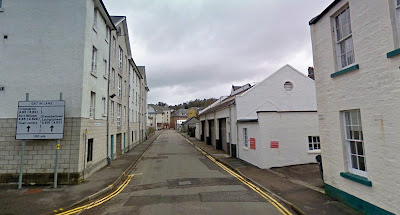A couple of weeks ago, I wrote about
Out Skerries, a group of islands off the coast of Shetland with a population of just 76 which are for sale. The fact Skerries are under crofting tenure means any purchaser's rights over them would be very limited. Indeed the crofters have a statutory right to buy the islands (compulsorily) from the purchaser at a price likely to be considerably lower than estate agents,
Knight Frank's price tag of £250,000.
Scalpay is an island off the coast of Harris in the Outer Hebrides. With 1,600 acres (650ha) and a population of 320, it's much bigger than Out Skerries. It's also more accessible from its parent archipelago in that it's connected to neighbouring Harris by a bridge. What Scalpay does share with Skerries, though, is that it's almost entirely subject to crofting tenure and its landlord is planning to dispose of the island. Unlike Skerries' landlord, however, he is planning to
gift Scalpay to its residents. This is not an excess of generosity but rather a reflection of the realities of being the landlord of croft land.
Scalpay is the most densely populated island on the west coast of
Scotland outside the Firth of Clyde. That's not due to its inherent
qualities for settlement but rather to the fact people were removed to
Scalpay from more desirable parts of Harris during the "Highland
Clearances" in the first half of the 19th century. But once there, some
made the most of the island's endowments in the shape of its natural
harbour by becoming fishermen. Thus, Scalpay's enforced population was
retained by, and even gained a degree of prosperity from, fishing.
 |
| North Harbour, Scalpay in the 1960s - photo credit Harrisman |
The high point of the Scalpay fishing industry was the 1960s & 70s.
The Highlands and Islands Development Board gave financial assistance
for new boats and built a pier. Twelve boats employed six people each.
In a good week, each crew member could earn over £500. Quite a boom for a
remote Hebridean island. You can read fascinating first hand accounts
here and
here.
But unfortunately it was a bubble rather than a boom. For reasons I
don't fully understand but probably due to overfishing (though not necessarily by Scalpachs), the fishery collapsed in the late 80s. Today, there are only a handful of much smaller fishing boats each only employing one or at most two people and it's an appalling irony that former Scalpay boats are now being "decommissioned"
with public money as you can read
here.
 |
| The bridge seen looking from Scalpay north west to Harris - photo credit JimC |
So in the 1990s Scalpay was in the doldrums. Salvation appeared to come in the shape of the bridge in 1997 and, shortly after, the opening of a factory to process farmed fish employing over 100 people. But the mid 2000s turned out to be one of the fish farming industry's periodic downturns and, as a result of "industry consolidation", the factory closed in 2005. (It has since re-opened as a facility for washing fish farm nets but employing only about a dozen people.) In more recent years, there has been further contraction with closure of Scalpay's only shop (2007, although happily it opened again in 2012 under co-operative management - see
Buth Scalpaigh), its old people's care facility (March 2012) and primary school (June 2012). As regards these last three facilities, the bridge has almost certainly proved to have been a double edged sword.
 |
| The north west corner of Scalpay showing the village clustered around the sheltered harbour. The bridge to Harris and fish/net washing factory of variable fortunes is conspicuous along the north coast. |
Scalpay was part of the North Harris Estate until it was sold off about 30 years ago to John Taylor, a London architect. The current landlord is a Fred Taylor who I assume is his son. Apart from about 50 acres around the lighthouse at the east end of the island and a 25 x 25 metre patch which used to be occupied by the MoD, the whole of Scalpay (except the houses and property belonging to third parties such as the lighthouse, church, school, shop, fish factory etc.) is under crofting tenure. There are 40 crofts yielding a rent of just £81 between them. Apparently, only a few of these are worked with their sheep grazing all the other crofts indiscriminately by common consent. Otherwise, the principal source of income to the landlord is around £2,000 a year wayleave payments from the Hydro Board for its electricity poles but that's largely neutralised by admin and accountancy etc. fees. There's no shooting or fishing on Scalpay to speak of so Mr Taylor is not giving very much away by offering this inheritance to the islanders.
Will accepting the offer improve their lot, economically?
In the last 15 years in Scotland, it's become axiomatic that taking land out of private hands and into community ownership is "a good thing". That's partly due to the success of the transformation on the islands of Gigha and Eigg. It's also due to the fact there's public and lottery funding available to community owners for investment in infrastructure which is not available to private owners so you're not really comparing like with like. But crucially, Gigha and Eigg are not entirely subject to crofting tenure. Their owners do actually own assets like houses and farms which can be improved or developed in the hands of a community owner by receipt of a slug of public/lottery money not available to a private owner.
But the case for community ownership is less compelling on islands like Scalpay (or Out Skerries) almost entirely subject to crofting tenure where the landlord's rights are so limited anyway. It's not a "bad thing" to do but nor is it a panacea. At least on Scalpay the landlord (facing realities) is proposing to
gift the island so there's no need to raid the lottery fund for a six figure sum to buy it.
To test my theory, let's look at the Feasability Study commissioned by the Scalpay Land Transfer Steering Group. You can download that
here. The priorities for development of the island this identifies are:-
- purchase the school from the Council for conversion to small business premises;
- lay moorings and a pontoon for yachtsmen; showers and laundry for yotties to be provided in the school;
- community wind turbine;
A proposal to reopen the old folk's care facility was deemed prohibitively expensive. But the point is that, apart from the turbine, it's not necessary to acquire the island to realise these aims. And even for the turbine, you don't need to acquire the
whole island, just a few hundred square metres of it will do. Community wind turbines have been established on
Tiree and
Westray (Orkney) without the need to acquire the whole of either of these islands.
There's anecdotal evidence that acquiring the estate acts as a catalyst which energises its community into taking other steps to improve its lot which ownership of the vast acres is not necessary to achieve. So the public/lottery money spent buying the estate is justified as a pump primer so long as the amount is not excessive. But on Scalpay, has that community awakening not already happened with the immense effort to take over the shop? Could that energy not now be redirected into taking over the school from the Council and installing the pontoon and the wind turbine etc.? Is the cost of buying the estate always justified or well targetted?
On Scalpay, it doesn't matter because the owner is proposing to donate the island (although £13,000 is being requested from public/lottery funds for the legal costs of the acquisition). But on other estates it matters a lot. On Pairc (pronounced "Park"), a crofting estate on Lewis, the owner is, understandably, expecting quite a lot of compensation for the loss of his share of a prospective commercial wind farm on the common grazings. Like Scalpay, the community's development plan (not currently available on Pairc Trust's
website) requires only a few hectares for affordable housing, a campervan park, a community turbine etc. There's no conflict between these legitimate aspirations and the wind farm on the rest of the common grazings so the move to acquire them boils down to a straight "We want public/lottery money to take that from you and give it to us" tussle.
 |
| Artist's impression of the Scalpay community wind turbine |
There are also hints of a rather unpleasant tendency to
blame privately owned estates as the scapegoats for all the problems being suffered by remote rural communities in times of cutback. For example, the land reformer Andy Wightman
said to the BBC about Applecross Estate in Wester Ross:
"It needs substantial investment. It needs more people living there and needs to increase the school roll. As long as this vast area of land is owned by a tiny number
of people who don't even live there and come to visit to do a bit of
shooting, I don't think the prospects are very good."
That's all very rousing stuff but what more could the estate do to fill the school? Is that an estate's responsibility anyway? Is it sensible to spend scarce public/lottery funds buying "vast areas" when a more focussed policy of buying really quite small areas would deliver the community's aspirations without burdening them with the responsibilities of becoming a large scale landlord?
I'm hoping to find some or all of the answers to these questions in James Hunter's latest book,
From the Low Tide of the Sea to the Highest Mountain Tops: Community Ownership of Land in the Highlands and Islands of Scotland which I shall be buying with my Christmas money this year. Professor Hunter made his name as a writer with the seminal and - as important - eminently readable
The Making of the Crofting Community which is required reading for anybody interested in the history of crofting.
Meanwhile, I leave you with a photo I took in 1990 in Tarbert, Harris before the bridge to Scalpay had been built. I was quite chuffed that the Scalpay Community Land Steering Group chose it as one of the banner photographs for their
website
POSTSCRIPT - Since I started writing this post (ages ago!), I learn from the excellent
Arnish Lighthouse blog that the people of Scalpay have voted by an overwhelming majority (197 for, 8 against) to accept the gift of the island and also - though by a much slimmer majority (110 for, 96 against) - to become part of the neighbouring
North Harris Trust community owned estate. That seems like an excellent middle course whereby the hassle of acquiring and owning the island can be minimised by drawing on the expertise in that regard already held by NHT and allowing a more uncluttered focus on delivering the priorities for Scalpay.



.jpg)



















